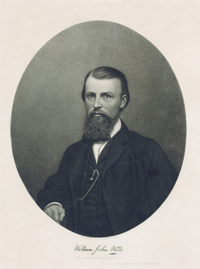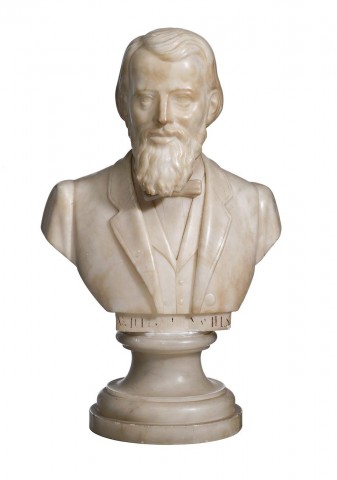BUST OF WILLIAM JOHN WILLS, c.1865
ARTIST UNKNOWN
alabaster
42.0 cm height (including base)
inscribed on base: WILLIAM JOHN WILLS
Private collection, South Australia
Private collection, Adelaide, acquired from the above in the 1980s
Private collection, Adelaide
Never in the history of Australian art has an expedition of inland exploration excited the imagination as did that of Burke and Wills. The biggest of its kind, the drama of its end with the tragic death of its leaders raised them to the status of national heroes. Known as The Victorian Exploring Expedition to the Gulf of Carpentaria, its very departure from Melbourne on 20 August 1860 was recorded in detail. William Strutt’s watercolour of the event has all the grandeur of a Roman triumphal procession as Burke, mounted on a ‘grey Arab charger’ leads the party of men, horses and exotic camels.1 The pomp continued in Nicholas Chevalier’s large oil, Memorandum of the Start of the Exploring Expedition, 1860, while S.T. Gill’s watercolour provided a more common touch.2 Ludwig Becker was the expedition’s artist and naturalist, and Henricus van den Houten, Thomas Clark, and George Lacy were among the contemporary artists drawn by the adventure. The fascination continued. In 1907 both John Longstaff and George Lambert created memorable works, with Sidney Nolan’s series belonging to more recent times.3
NPG Wills_Sadd.jpg

HENRY SADD
William John Wills, 2nd. In command
of the Victorian Expedition, 1860
mezzotint
31.5 x 25.5 cm (image)
courtesy of National Portrait
Gallery, Canberra
William John Wills’ (1834 – 1861) fame rose from his role as second in command of what is generally known as the Burke and Wills expedition, the first to cross the continent of Australia from south to north, namely from Melbourne to the Gulf of Carpentaria. Disciplined, loyal and a steadying influence on the impetuous Robert O’Hara Burke, the modest Wills has a rightful claim to being the real hero of the ill-starred event. Born at Totnes, in Devon, England, Wills studied medicine before coming to Melbourne on 3 January 1853. The study of surveying led him to the Magnetic Observatory under Georg von Neumayer, who, as a member of the Expedition’s Committee, encouraged Wills to join. Appointed surveyor, astronomical and meteorological observer in July 1860, Wills was third in command under Burke.
Not long into the journey, second-in-command George Landells’ conflict with Burke led to his replacement by Wills. Burke, Wills, John King and Charley Gray made the famous dash from Cooper’s Creek to the Gulf of Carpentaria, reaching the mangroves on the Flinders River estuary on 9 February 1861. The disastrous return journey saw the death of Gray before they reached Cooper’s Creek. Abandoned only a few hours earlier by the Depot Party, Wills died there alone about 28 June 1861. Burke followed, King surviving through the help of local Aborigines. In 1862 their bodies were disinterred and taken to Melbourne, lying in state for two weeks before a State Funeral saw them finally resting in the Melbourne General Cemetery. In 1865, Charles Summers’ (1825 – 1878) bronze Burke and Wills Monument was unveiled in Melbourne.
Our alabaster bust of Wills was once a pair with Burke. Observant, with a keen sense of the ridiculous, Wills was said to have a ‘clear … complexion, an expressive eye that always outstripped his tongue … golden hair, a thick tawny beard, a smile at once intellectual and sympathising, a light, clean, agile frame’.4 The remarkable fidelity of the mezzotint portrait of Wills by Henry Sadd (1811 – 1893) in the National Portrait Gallery, Canberra comes from it being based on an ambrotype taken by Thomas Hill of Melbourne in 1860.5 Both confirm the striking likeness of our bust.
1. William Strutt, The Start of the Burke and Wills Exploring Exhibition from Royal Park, Melbourne, August 20, 1860, 1861, watercolour, Mitchell Library, State Library of New South Wales, Sydney. Strutt quoted in Mackaness, G. (ed.), The Australian Journal of William Strutt, A.R.A., 1850-1862, Halstead Press, Sydney, 1958, 2 volumes, p. 26
2. Nicholas Chevalier, Memorandum of the Start of the Exploring Expedition, 1860, Art Gallery of South Australia, Adelaide, M.J.M. Carter AO Collection. S.T. Gill, Burke Expedition Starting from Royal Park, Melbourne, c.1860 – 61, from a set of ten watercolours on the Burke and Wills expedition in the Dixson Gallery, State Library of New South Wales, Sydney.
3. John Longstaff’s large oil painting, Arrival of Burke, Wills and King at the Deserted Camp at Cooper's Creek, Sunday Evening, 21st April 1861, is in the collection of the National Gallery of Victoria, Melbourne. George Lambert’s watercolour, Burke and Wills on the Way to Mount Hopeless, is in the Bendigo Art Gallery, Victoria. Sidney Nolan’s numerous paintings include Burke at Cooper’s Creek, 1950, National Gallery of Australia, Canberra.
4. Quoted in McLaren, I., ‘Wills, William John (1834-1861), Australian Dictionary of Biography, vol. 6, Melbourne University Press, 1976, pp. 410 – 11
5. William John Wills, 2nd. In command of the Victorian Expedition, 1860 by Henry Sadd, mezzotint, National Portrait Gallery, Canberra.
DAVID THOMAS
